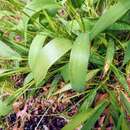Comprehensive Description
provided by North American Flora
Panicum latifolium L. Sp. PL 58. 1753
Milium latifolium Moench, Meth. 204. 1794.
Panicum macrocarpon LeConte; Torr. Cat, PI. N. Y. 91. 1819.
Panicum Schnecki Ashe, Bull. N. Car. Exp. Sta. 175: 116. 1900.
Vernal plants in clumps of few to several culms from a knotted crown; culms rather stout, 45-100 cm. high, erect, glabrous, or the lower internodes sometimes sparsely pubescent, the nodes glabrous, rarely with a few hairs; leaf -sheaths shorter than the internodes, ciliate on the margin, a pubescent ring at the juncture with the blade, otherwise glabrous, or the lower sparsely downy; ligule nearly obsolete; blades rather thin, ascending or spreading, 8-18 cm. long, 1.5-4 cm. wide, the lower smaller, acuminate, cordate-clasping at the base, glabrous, rarely sparsely pubescent on one or both surfaces, short-ciliate at least toward the base; panicles usually short-exserted or sometimes finally long-exserted, 7-15 cm. long, about two thirds as wide, the long, few-flowered, nearly simple branches stiffly ascending; spikelets rather shortpediceled, commonly more or less clustered in twos or threes, 3.4-3.7 mm. long, 1.8-2 mm. wide, oval-obovate, turgid, sparsely pubescent; first glume one third to half the length of the spikelet, pointed; second glume and sterile lemma scarcely covering the fruit at maturity; fruit 3 mm. long, 1.6-1.8 mm. wide, elliptic, minutely pubescent on the obscurely apiculate apex.
Autumnal phase more or less spreading, branching from the middle nodes, the upper leaves of the branches crowded and spreading, not much reduced, the small panicles partly included.
Type locality: Northeastern United States.
Distribution: Maine to Minnesota, and south to North Carolina and Kansas.
- bibliographic citation
- George Valentine Nash. 1915. (POALES); POACEAE (pars). North American flora. vol 17(3). New York Botanical Garden, New York, NY
Physical Description
provided by USDA PLANTS text
Perennials, Terrestrial, not aquatic, Rhizomes present, Ste ms nodes swollen or brittle, Stems erect or ascending, Stems caespitose, tufted, or clustered, Stems terete, round in cross section, or polygonal, Stem internodes hollow, Stems with inflorescence less than 1 m tall, Stems, culms, or scapes exceeding basal leaves, Leaves mostly basal, below middle of stem, Leaves conspicuously 2-ranked, distichous, Leaves sheathing at base, Leaf sheath mostly open, or loose, Leaf sheath hairy, hispid or prickly, Leaf sheath hairy at summit, throat, or collar, Leaf sheath and blade differentiated, Leaf blades lanceolate, Leaf blades ovate, Leaf blades 2-10 mm wide, Leaf blades 1-2 cm wide, Leaf blades 2 or more cm wide, Leaf blades mostly flat, Leaf blades mostly glabrous, Leaf blades more or less hairy, Ligule present, Ligule a fringed, ciliate, or lobed membrane, Inflorescence terminal, Inflorescence an open panicle, openly paniculate, branches spreading, Inflorescence a contracted panicle, narrowly paniculate, branches appressed or ascendi ng, Inflorescence solitary, with 1 spike, fascicle, glomerule, head, or cluster per stem or culm, Inflorescence branches more than 10 to numerous, Peduncle or rachis scabrous or pubescent, often with long hairs, Flowers bisexual, Spikelets pedicellate, Spikelets dorsally compressed or terete, Inflorescence or spikelets partially hidden in leaf sheaths, subtended by spatheole, Spikelet less than 3 mm wide, Spikelets with 1 fertile floret, Spikelets with 2 florets, Spikelets solitary at rachis nodes, Spikelets all alike and fertille, Spikelets bisexual, Spikelets disarticulating below the glumes, Rachilla or pedicel glabrous, Glumes present, empty bracts, Glumes 2 clearly present, Glumes distinctly unequal, Glumes equal to or longer than adjacent lemma, Glume equal to or longer than spikelet, Glumes 3 nerved, Glumes 4-7 nerved, Lemma similar in texture to glumes, Lemma coriaceous, firmer or thicker in texture than the glumes, Lemma becoming indurate, enclosing palea and caryop sis, Lemma 3 nerved, Lemma 5-7 nerved, Lemma 8-15 nerved, Lemma glabrous, Lemma apex truncate, rounded, or obtuse, Lemma awnless, Lemma margins inrolled, tightly covering palea and caryopsis, Lemma straight, Palea present, well developed, Palea about equal to lemma, Stamens 3, Styles 2-fid, deeply 2-branched, Stigmas 2, Fruit - caryopsis.

